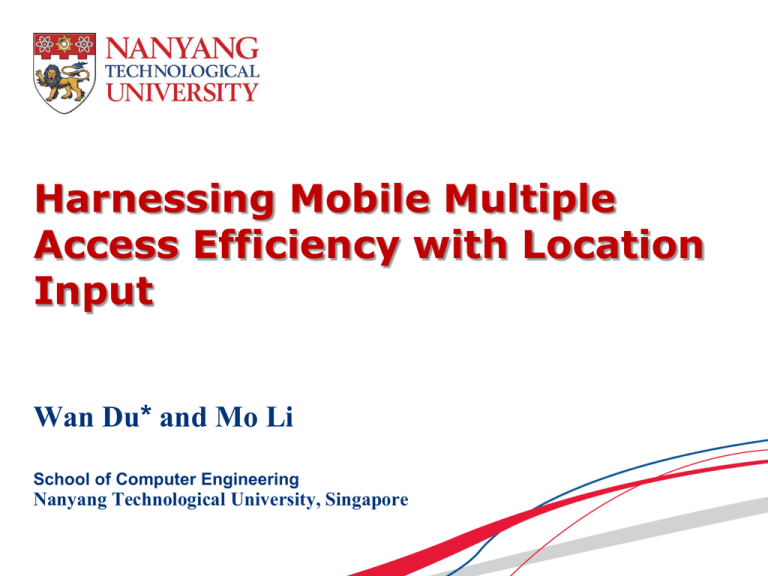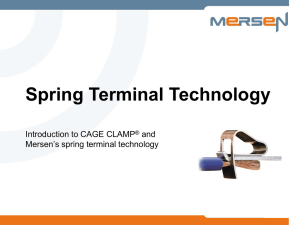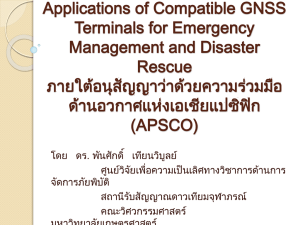Slides - PDCC - Nanyang Technological University
advertisement

Harnessing Mobile Multiple Access Efficiency with Location Input Wan Du* and Mo Li School of Computer Engineering Nanyang Technological University, Singapore Main access to WLAN “Smart phones overtake client pcs in 2011,” 2012. www.canalys.com/newsroom/smart-phones-overtake-client-pcs-2011 2 Pervasive Location Information • Outdoors – GPS (meters) • Indoor Localization – Sound (centimeter) – WiFi (meter) – Camera (meter) 3 Location Based Applications • Navigation • Augmented reality • Fine-grained location in supermarkets 4 Key Observation Location error of << localization Indoor: <1m Outdoor: <13.7m Communication range of WiFi Indoor: >50m Outdoor: >200m • Improving the communication efficiency using location input – Hidden terminal and exposed terminal problems in mobile WLAN • In two campus WLAN of CENTAUR, 40% links of exposed terminals and 10% links with 70% throughput reduction due to hidden terminals. 5 outline • • • • Problem review and State-of-the-Art Design of CO-MAP Implementation and Evaluation Conclusions 6 Hidden Terminal Collision! • Detect this relation • Prevent concurrent transmissions 7 State-of-the-Art • Extra coordination channel – DC-MAC (TPDS 2012) • New hardware or USRP implementation • Conflict map based scheduling – RXIP (INFOCOM’ 12) • Overhead of map learning • Centralized control for downlinks 8 Exposed Terminal Collision! • Detect this relation • Enable concurrent transmissions • Multiple exposed terminal problem 9 State-of-the-Art • Extra coordination channel – Attached-RTS (TPDS 2012) • New hardware or USRP implementation • Conflict map based scheduling – CMAP (NSDI’ 08) and CENTAUR (MobiCom’ 09) • Overhead of map learning • Multiple exposed terminal problems • Centralized control for downlinks 10 Co-Occurrence MAP - Overview log normal shadowing propagation model Fast Uniform Co-Occurrence MAP Exposed Terminals Enchanced CSMA Maximize spatial reuse Hidden Terminals Distributed Dynamic packet size Minimize collision 11 Exposed Terminal 12 Exposed Terminal 13 Concurrent Transmissions 14 Concurrent Transmissions 15 Concurrent Transmissions Multiple Exposed Terminals Enhanced CSMA 16 Concurrent Transmissions 17 Concurrent Transmissions ACK Lost Problem Windowed ACK 18 Hidden Terminal 19 Hidden Terminal 20 Hidden Terminal Important Parameters: Number of HTs Packet Size 21 Dynamic Packet Length for Hidden Terminals Packet size Probability of node i transmiting in slot s Number of Number of hidden terminal contending nodes 22 Implementation • Testbed of six laptops – Intel Wireless 4965AGN network adapter – MAC80211 and iwlegacy wireless drivers. • Three Components – CO-MAP – Header and concurrent ET transmission – Packet length adaptation • Data rate adaptation – Minstrel (Default) 23 Implementation • Header in data packets – Thirteen bytes (address and CRC) in PHY header 24 Evaluation – Exposed Terminal 78% 25 Evaluation – Hidden Terminal 39% 26 Large Scale Network on NS-2 • Network layout – Three APs separated about 60m – Nine clients. – Thirty topological configurations • 48% exposed links and 19% hidden terminals 27 Large Scale Network on NS-2 39% 28 Large Scale Network on NS-2 39% 19% 29 Tolerance to Position Inaccuracy Location Error Range Misclassification percentage Wrong ET Missing ET Wrong HT Missing HT 1m 0.2% 0.3% 0.2% 0.2% 5m 1.2% 1.4% 1.1% 0.8% 10m 2.1% 2.3% 2.4% 1.4% 30 Conclusion • A practical work leveraging pervasive location information to improve spatial reuse and reduce hidden collisions in mobile WLAN • Distributed design with rapid construction of conflict map • Successful practice using sensor hints in protocol design 31 Thanks. Questions? Wan DU, duwan@ntu.edu.sg Research Fellow @ NTU, Singapore









